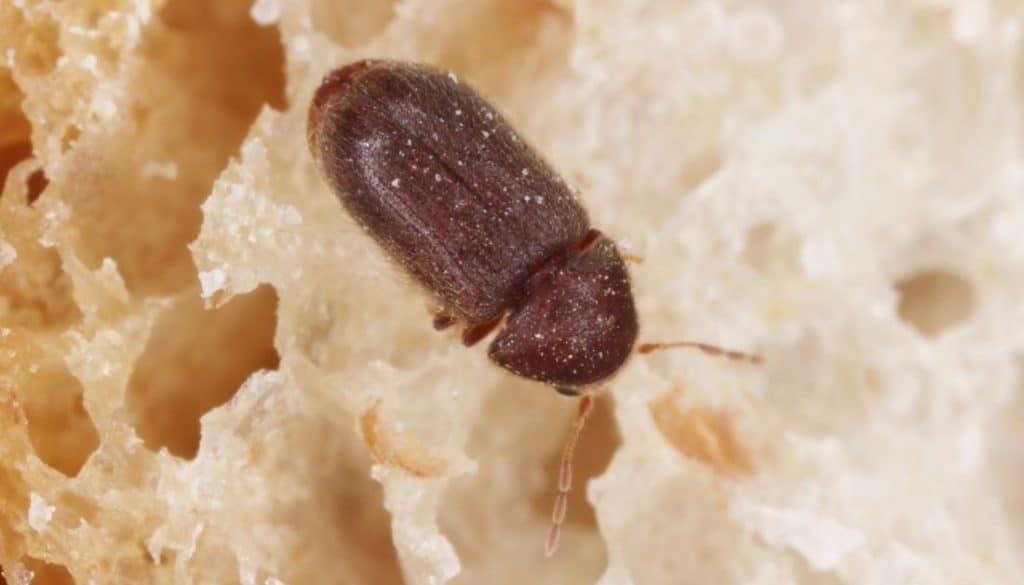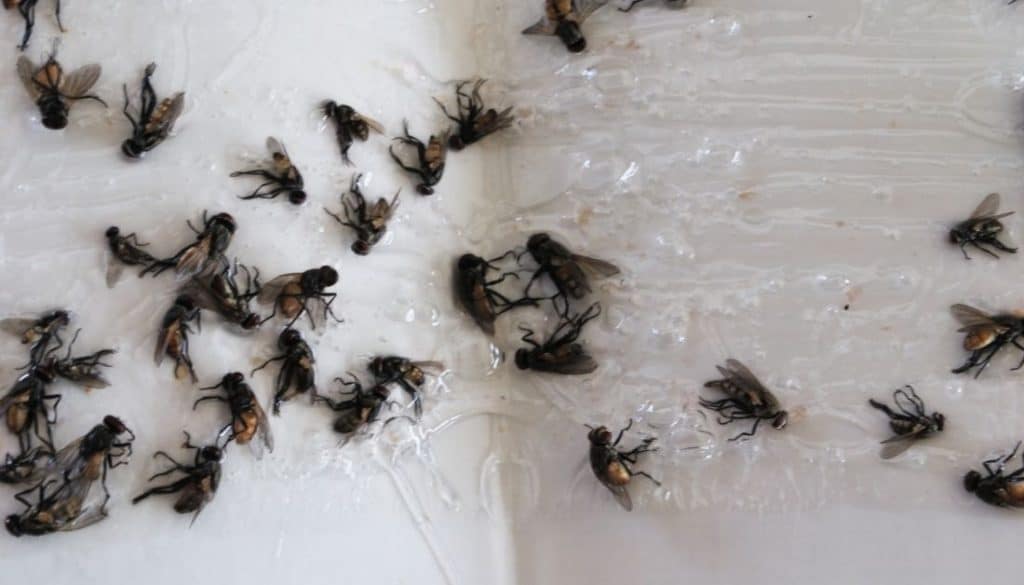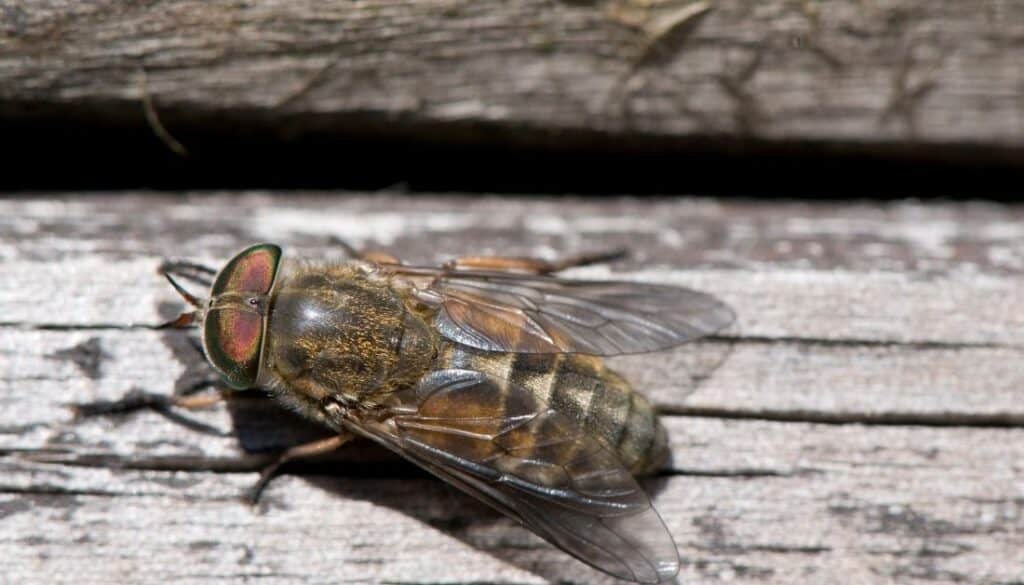Do you know that the light from your home can play a significant role in causing a bug infestation?
Yes, it does.
And light can attract a slew of little flying bugs that can bite you too.
In this guide, you’ll find 13 tiny flying bugs attracted to light. These bugs invade homes by following the light from the glowing bulbs.
You’ll find out at what season these bugs are prone to fly inside your home, the risks these tiny flying bugs bring, and how you can stop them.
And a lot more. Keep reading.
Why Are Some Flying Insects Attracted To Light? – The Phototaxis-Positive Flying Insects

Ever wondered why light attracts some flying insects? Well, there’s a biological reason for it.
Without getting too much into the science of it, let us explain.
There’s a category of flying bugs that are known as phototaxis-positive.
A light source triggers a response in the phototaxis-positive bugs that causes them to follow the light source.
Before light bulbs, phototaxis-positive bugs use light from the sun, moon, and even stars to navigate.
They’ll use the light to fly in a straight line, known as transverse navigation, to reach new hiding places or food sources.
When the phototaxis-positive bugs see glowing bulbs, their bodies trigger the same reaction causing them to fly into the light bulbs.
Multiple bulbs confuse these flying bugs, which causes them to fly in a random fashion rather than in a straight line.
Bugs specifically pick up the UV band in the light spectrum to use it for navigation. And the UV band in the light from the bulbs attracts these bugs.
Many people, especially farmers, use UV light bulbs to trap the pests that cause damage to crops and flowers.
There’s also another theory, which is uncorroborated, that some species of bugs will fly to the light source to save themselves from predators lurking in the dark.
Flowers of specific colors also reflect the UV light that draws these tiny flying insects. That also causes the bugs to mistakenly presume that the light from the bulb is a food source.
Some bugs are phototaxis-negative. These bugs prefer to live in the dark, and light repels them.
Examples of phototaxis-negative bugs are cockroaches, ants, spiders, and centipedes. These bugs avoid light and hide in dark places.
Now that you’ve got a fair idea of why light attracts flying insects, it’s time to find out the tiny flying bugs that artificial light attracts to your home.
13 Tiny Flying Bugs Attracted To Light And Invade Homes
- Fungus gnats
- Biting midges
- Stink bugs
- Carpet beetles
- Flying ants
- Flying termites
- Weevils
- Drugstore beetles
- Moths
- Bottle flies
- House flies
- Horse flies
- Mayflies
All these bugs are phototaxis-positive, except one, the horse fly. Light reflected from the water’s surface attracts the horse flies.
Let’s get into each of these bugs and find out more.
Fungus Gnats

Fungus gnats top our list of tiny flying bugs that light attracts. These mosquito look-alikes are small and black, the most pervasive tiny flying bugs in homes.
The fungus gnats’ sources in your property are the damp areas of your yard and the organic wastes.
So, places like wet soil beds, damp compost piles, and highly moist organic wastes are the source of these bugs.
Fungus gnats enter homes by following the light through open doors and windows.
When the windows are closed, they try hard to sneak inside by repeatedly banging themselves on the windows.
That’s why fungus gnats and many other bugs on the list are those tiny black bugs near windows trying to make their way into the house.
Inside the house, fungus gnats will go to moisture.
And light bulbs in every room will attract these bugs.
So, if you see tiny black flying bugs, which look like mosquitoes, hovering around the light bulbs in your bedroom, then they’re fungus gnats.
Light doesn’t attract mosquitoes.
Biting Midges or No-See-Ums

Biting midges are nasty tiny black flying bugs that bite. They live and breed in the damp areas near water bodies such as lakes, ponds, and streams.
But light also attracts biting midges.
And biting midges fly inside homes during the early morning or just before sunset.
Biting midges bite.
They’ve got robust and sharp mouth parts that they insert into the skin. Their bites are itchy and can cause red welts on the skin.
But, unlike the fungus gnats, the biting midges can’t survive in your home for long. It’s because their ideal habitat is outdoors, not inside your home.
Stink Bugs

Stink bugs thrive in the warm climate. So, they’re active starting from March to September.
Many homeowners report stink bugs in their homes and even inside cars during this period.
It’s because light from homes and vehicles attracts stink bugs.
Other reasons that play a significant role in attracting stink bugs inside your home are moisture and the smells of fruits.
These bugs will hover around the light bulbs. And when you turn them off, stink bugs will find a place to hide inside your home.
But stink bugs don’t bite. They produce a nasty odor.
Stink bugs produce chemicals from their thorax region when they’re under threat. Those chemicals have a stench.
This behavior is one of their ways of defending themselves.
Carpet Beetles

Carpet beetles are tiny black, brown, or multi-colored beetles that enter homes to lay eggs in stored food and on natural fabrics.
They’re most active starting from the spring till early fall. It’s during this period they breed and lay eggs.
Carpet beetles can crawl and fly. And the light from your home plays a significant role in drawing these damaging pests inside your home.
But they can also crawl through the thinnest of gaps and tiniest of holes on your home’s windows and walls.
Carpet beetles don’t bite. And they don’t spread any diseases. The adult carpet beetles are not damaging pests. Their larvae are the ones that cause damage.
The carpet beetle’s larvae damage stored food and expensive natural fabrics like leather, fur, silk, feathers, and wool.
Flying Ants

Although adult ants are phototaxis-negative, the flying ants, reproductives, or alates, are highly phototaxis-positive.
Flying winged ants leave their current colonies in swarms to find a new place to start a new colony.
And light attracts these flying ants.
Winged flying ants will follow the light coming from your home. Once inside your home, these ants will lose their wings and mate.
After mating, they’ll hide inside your home to start an ant infestation.
Carpenter ants alates are the most damaging. These wood-boring ants will drill into your home’s damp wood to lay eggs and build nests.
Swarms occur during the early summer or after occasional rains.
Flying ants don’t bite neither they carry any pathogens. However, they can be very irritating if you come on their flight path.
Flying Termites

Flying termites are alates of termites. They follow the exact mechanism as the flying ants.
But flying termites are more damaging than flying ants.
After losing their wings, these termites will enter your home. And they’ll infest your furniture, hardwood floor, and structural lumber to start an entire colony.
Alates of drywood termites bring the most risk.
It’s because they prefer targeting the structural lumber of your home and their infestation is very difficult to spot at the early stages.
Fumigation is the only reliable way to eliminate drywood termites in your home.
Weevils

Weevils are tiny brown beetles that fly inside your home, following the light from your home.
However, that’s one of the ways they get inside your home.
Weevils are pantry pests and can infest grains and flour. So, they can also be present in the grain bags you buy from the grocery store.
Weevils prefer moist places to hide too. That’s one of the reasons that you can find weevils in the bathroom.
Weevils are harmless bugs. And they don’t bite.
But they soon become a nuisance because these bugs multiply quickly.
You don’t need any pesticide sprays to get rid of them. Extensive cleaning and controlling the moisture inside your home will remove the weevils.
Drugstore Beetles

Another pantry beetle that light attracts, and causes them to fly inside your home, is the drugstore beetle.
Drugstore beetles got their name because they infest medicines stored in pharmacies.
Drugstore beetles, also known as biscuit beetles, infest stored food, especially cereals, bread, herbs, and pasta in your kitchen and pantry.
But the most common way drugstore beetles get inside homes is by being present in the dry food packets you buy.
Moths

Light from your home attracts all types of house moths like rice moths, cloth moths, Indian meal moths, and White-shouldered house moths.
Each of these moths is a pantry moth, except the cloth moth. Like the carpet beetles, the cloth moth will lay eggs on the fabric.
It’s the cloth moth’s larvae that cause damage to the fabric. And their larva can damage all types of fabric, including synthetic blend fabrics.
The cloth moth’s larvae can also land in your bed, feeding on the dirt, food stains, and sweat stains on your bed sheets and pillow covers. That’s why they’re also known as bed worms.
None of these moths bite humans or spread any diseases.
But they become a nuisance soon. And after the occasional rains in the summer months, these moths come out in droves and hover around the light bulbs.
Bottle Flies

Bottle flies are tiny green or blue flies that nest and breed on decaying organic matter outdoors.
These flies are highly unhygienic as the odor from feces and rotting carcasses of animals, birds, and insects attract them.
Bottle flies, also known as bottle flies, feed and lay eggs on these decaying substances.
Bottle flies will also feed on the flower’s nectar if there’s no garbage around. Hence, they’re pollinators too.
But light attracts bottle flies. And inside your home, they’ll lay eggs in your kitchen and bathroom trash cans.
They will also sit on your food and can pass the pathogens they’re carrying to your food too.
That’s risky.
Bottle flies enter homes in large numbers and soon become a nuisance.
It happens in homes that have a lot of decaying organic matter like foliage, firewood, and mulch beds on their property.
House Flies

Light also attracts house flies. But light isn’t solely responsible for house flies’ presence in your home.
Decaying organic matter, dirty neighborhood, choked drainpipes, and organic wastes around your home play a role in house fly infestation.
But if these house flies are outdoors in your yard or garden, the light from your home will draw them inside.
House flies’ eyes are sensitive to the UV spectrum in the house bulbs, especially LED bulb’s wavelengths.
Horse Flies

Horse flies aren’t typically attracted to the UV spectrum of light. But they’re more sensitive to the reflected light, especially from the water.
Horse flies are common in barns. They nest in the organic matter lying around in the barn.
Horse flies are highly active during sunrise. And it’s during this period they carry on their feeding activities.
Many people observe the sudden appearance of horse flies inside the home at dawn.
And horse flies bite humans and horses too. They’ve got sharp mouth parts that cut through the skin and leave a nasty bite.
Mayflies

Light attracts another type of flies that look like flying termites. It’s the mayflies. These flies don’t bite or sting and they’re not damaging pests either.
But they hover around light bulbs in huge swarms. They die the following day, resulting in piles of dead mayflies near windows, doorways, and patio decks.
Mayflies are not present everywhere. Their presence is a clear sign of fresh air and pollution-free environments.
Mayflies can enter homes through open doors and windows.
Their presence in homes is an irritating nuisance as they fly randomly and can accidentally get inside ears and nose.
These flies can also attract bugs and reptiles like geckos that feed on them.
How To Stop These Tiny Flying Insects That Light Attracts Inside Your Home
It’s quite tricky. You cannot completely stop them from entering your home.
You can’t live in the dark by switching off your light bulbs to ensure that these tiny flying insects don’t enter your home.
But there are certain steps that you can take to minimize their entry inside the home.
Here’s what you can do.
Install Bug Zappers And Bug Repelling Bulbs
Bug zappers will help you control these flying insects from flying inside your home.
There are bug zappers with light that attract these bugs and electrocute them.
Installing them in your outdoor area, on the patio deck, near windows, and doorways will minimize the chances of flying insect invasion in your home.
There are also bug-repelling light bulbs that don’t emit UV rays. And hence they don’t attract these flying bugs.
In addition to bug zappers, you can also install these bug-repelling bulbs in various sections of your home to keep the bugs away.
Maintain Cleanliness In Your Yard And Outdoors
Most of these little flies on the list live and breed on organic wastes. Hence, it would help if you keep your outdoors clean.
Get rid of any foliage, tree stumps, and rotting pieces of firewood from your yard.
Also, dispose of the trash from your trash bins regularly. Wastes in the trash bins start to decay and attract many bugs, including roaches and ants.
Choked gutters also become prime real estate for these flies. So, keep them clean as well.
Control The Dampness Levels Of Your Yard
Along with the wastes, dampness is also responsible for making your property a breeding ground for these little flying bugs.
Excessive dampness causes the wastes to decay. That makes the organic wastes both a feeding and breeding ground for bugs.
So, check out for any leaking pipes. If there are any, fix them.
Also, ensure that there’s no water stagnation issue in your yard.
Fill up any potholes that hold water, stop overwatering your yard, and remove things like tires and containers that can hold water.
Water in these places becomes a breeding ground for mosquitoes too.
Install Window Screens With Fine Mesh
Many bugs will escape the zappers and try to make their way into your home.
So, as an extra precautionary step, use window screens with fine mesh on your windows.
These window screens help to stop flying bugs from entering your home.
And they’re beneficial in keeping your home safe from invasive pests like flying ants and flying termites during the spring and summer seasons.
It’ll be best to install these window screens on the vents of your attic too. The ducts in the attic are entry points to many bugs and even rodents.
Seal Gaps And Cracks
The beetles on the list are not only efficient fliers but also crawlers.
They’ll sneak through the thin gaps and cracks on your window sills, frames, doors, and home walls.
So, caulk those gaps with a quality sealant.
To make it more effective, you can also use window stripping to seal the gaps between the window panels and frames.
Conclusion
Tiny flying bugs entering your home following the light from the bulbs is a natural phenomenon.
But not all these bugs are harmless. Many of them bite and bring infestation risks.
To keep these bugs away, you need to use things like bug zappers and eliminate their sources from your property.
So, if you’re sick and tired of these tiny fliers into your home, use the steps laid out in the post.


